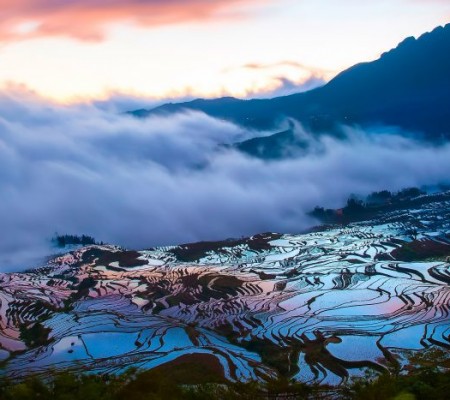
Shizhi Village of Shigu Town in Yulong County, Lijiang
Geographical Location
Shizhi Village(石支村) is located in Renhe Village Committee, Shigu Town, Yulong Naxi Autonomous County, Lijiang City, Yunnan Province. It is a typical mountainous village, nestled among rolling mountains and surrounded by lush green hills. The village enjoys a pristine and beautiful natural environment. It is 13 kilometers away from Renhe Village Committee and 16 kilometers from Shigu Town. The area has an altitude of 2100 meters, with an annual average temperature of 10℃ and an annual precipitation of 900 millimeters. The climate is suitable for growing crops such as corn, potatoes, and white kidney beans. Although located in a mountainous area, the transportation conditions have gradually improved in recent years, making it possible for tourists to explore this untouched land.
Ethnic Groups and Traditional Skills
Ethnic Composition
Shizhi Village is a traditional village with the densest settlement of the Pumi people. There are also a few people from other ethnic groups living here. The Pumi people have developed unique cultural traditions over a long period of production and life, which form the core and soul of the village’s culture. Different ethnic groups respect each other and live in harmony, creating a diverse and inclusive cultural atmosphere in the village.
Traditional Skills
-
Pumi Handicraft Weaving (普米族手工编织): Pumi women are skilled in handicraft weaving. They use local abundant materials such as bamboo, hemp, and rattan, and rely on skills passed down from generation to generation to carefully weave practical and beautiful handicrafts such as bamboo baskets, back baskets, and rattan baskets. The weaving techniques are diverse, and the patterns are rich in ethnic characteristics, such as common diamond patterns and meander patterns. These handicrafts not only have practical value but also reflect the unique aesthetic taste of the Pumi people. Visitors can watch the weaving process on – site in the village’s handicraft workshops and even try it themselves to experience the charm of traditional handicraft weaving.
-
Traditional Carpentry Skills (传统木工技艺): The carpentry skills in Shizhi Village have a long history. Villagers are good at selecting high – quality local wood, such as pine and walnut, to make various wooden utensils. From daily – use furniture like tables, chairs, and cabinets to exquisite wooden carvings, each piece of work embodies the craftsmen’s efforts. Carpenters use traditional tools such as saws, axes, and chisels to carve and join the wood into items that are both practical and beautiful. Some woodcarvings feature patterns of Pumi myths, legends, and natural totems, carrying profound cultural connotations.
-
Specialty Food Preparation (特色饮食制作): The Pumi people have a unique food culture, and the preparation of “pipa meat” is particularly outstanding. Made from high – quality local pork, it goes through multiple processes such as slaughtering, curing, and air – drying. The finished product is named for its resemblance to a pipa (a traditional Chinese musical instrument), with firm meat and a rich flavor that can be preserved for a long time. In addition, the Pumi people’s Surma wine is also distinctive. Made from barley and other grains, it is fermented using traditional brewing techniques and has a mellow taste. It is indispensable in Pumi festivals and daily life. Visitors can visit villagers’ homes to learn how to make these specialty foods and taste authentic Pumi cuisine.
Customs and Festivals
Daily Customs
-
Dietary Customs (饮食习俗): The Pumi people mainly eat corn, wheat, and potatoes as staple foods, with a preference for sour and spicy flavors. At the dining table, the etiquette of respecting the elderly and honoring the elders is very important. Elders start eating first, followed by the younger generations. In addition to the special “pipa meat,” the Pumi people have many unique dishes, such as baba made from buckwheat flour, which is best enjoyed with the local sour vegetable soup. Thanks to the rich forest resources around the village, villagers also consume wild mountain delicacies such as fiddlehead ferns and mushrooms, which are often cooked by stewing or roasting.
-
Living Customs (居住习俗): The traditional housing of the Pumi people in Shizhi Village used to be mostly log – cabin – style houses, made from round logs stacked layer by layer, with strong insulation properties. Nowadays, most houses have been transformed into stone – walled tile – roofed houses, but they still retain the traditional architectural style and layout. The houses generally face north to south, with an emphasis on lighting and ventilation. The courtyards are spacious and used for drying crops and raising livestock. The interior of the house is simply decorated, with a fireplace at the center. The fireplace is not only used for heating and cooking but also serves as an important place for family gatherings and communication.
Important Festivals
-
Wuxi Festival (吾昔节): Also known as the Pumi New Year, it is the most important festival for the Pumi people, usually held on the sixth day of the twelfth lunar month and lasting for 3 – 5 days. Before the festival, every household cleans their house and prepares New Year’s goods. On New Year’s Day, people dress in their finest clothes, worship their ancestors, and pray for favorable weather and a good harvest in the coming year. During the festival, grand song and dance activities are held, such as the “Cuocuo Dance,” where people hold hands and form a circle, singing and dancing together in a lively atmosphere. In addition, there are traditional sports activities like horse racing and wrestling, showcasing the vitality and bravery of the Pumi people.
-
Turning – Mountain Festival (转山节): On the fifteenth day of the seventh lunar month every year, the Pumi people celebrate the Turning – Mountain Festival. The surrounding mountains, such as “Shizhigong,” are regarded as sacred mountains by the Pumi people. On the festival day, villagers wear traditional costumes and bring sacrifices to worship at the sacred mountains. They walk around the mountains, praying for the gods’ blessings of peace and a good harvest. During the walk, they hold chanting and blessing ceremonies, creating a solemn and solemn scene. This festival is also a good opportunity for young Pumi men and women to interact and express their feelings through singing and dancing.
-
Tasting New Festival (尝新节): When the crops are harvested, the Pumi people hold the Tasting New Festival. People steam the newly – harvested grains into rice and baba, first offering them to their ancestors and gods to express their gratitude, and then the whole family enjoys the food together. The Tasting New Festival is not only a celebration of the harvest but also an important carrier for the Pumi people to pass on their culture of gratitude.
Ancient Architecture
Although Shizhi Village is located in a mountainous area, it still has some ancient buildings with ethnic characteristics. Some traditional log cabins, despite the passage of time, still retain their simple appearance. These log cabins are made of round logs as the main structure, with thick walls and wooden boards covering the roofs, which are pressed with stones. The interior space of the log cabins is reasonably laid out, with the fireplace located in the center of the house, surrounded by furniture such as tables, chairs, and beds. The doors, windows, and beams of the log cabins are carved with simple but meaningful patterns, such as auspicious flowers and animals, reflecting the Pumi people’s aesthetic concepts and their longing for a better life. In addition, there are some ancient stone walls and simple stone bridges in the village. These buildings blend in with the surrounding natural environment and witness the historical changes of Shizhi Village. In recent years, the local government and villagers have paid more and more attention to the protection and restoration of ancient buildings, allowing these old buildings to continue to carry the cultural memory of the Pumi people.
Tourism Resources
Natural Scenery
-
Forest Landscape (山林风光): The surrounding mountains of Shizhi Village are covered with dense forests, with a high forest coverage rate and a wide variety of trees, including common species such as pine, fir, and cypress, as well as some rare wild plants. Walking in the forest, you can breathe in the fresh air, hear the chirping of birds, and occasionally see small animals such as squirrels and hares darting through the trees. The forest has different scenery in each season. In spring, flowers bloom in a riot of colors; in summer, the green trees provide a cool shade, making it an ideal place for summer retreat; in autumn, the forest is painted in layers of gold and red; in winter, it is covered in snow, presenting a unique charm. Visitors can hike along the forest paths to enjoy the tranquility and beauty of nature and explore the mysteries of the forest.
-
Terrace Landscape (梯田景观): The surrounding area of the village is distributed with terraced fields, which are neatly arranged. These terraced fields are the crystallization of the hard work of generations of villagers and, together with the surrounding mountains and villages, form a beautiful rural picture. In different seasons, the terraced fields present different scenery. In spring, the terraced fields filled with water are like mirrors reflecting the blue sky and white clouds; in summer, the green crops cover the terraced fields, full of vitality; in autumn, the golden rice sways in the breeze, presenting a scene of harvest; in winter, although the terraced fields are slightly desolate, their lines are still beautiful. Visitors can overlook the panoramic view of the terraced fields from a high place or walk into the fields to experience farming activities and feel the charm of agricultural culture.
Cultural Scenery
-
Pumi Cultural Experience (普米族文化体验): Visitors can delve into Pumi families to experience their daily lives. Learn traditional Pumi handicraft skills, taste special food, and participate in family sacrifices and other activities. The village regularly holds Pumi cultural activities such as song and dance performances and traditional handicraft displays, in which visitors can actively participate to gain a deeper understanding of the unique cultural connotations of the Pumi people. In addition, you can also visit the Pumi folk museum (if available) to get a comprehensive understanding of the history, culture, and customs of the Pumi people through physical objects, pictures, and texts.
-
Red Cultural Relics (红色文化遗迹): Although there are no direct red cultural relics in Shizhi Village, the surrounding Shigu Town is rich in red history. In April 1936, the Red Second and Sixth Armies passed through Lijiang during the Long March, and Shigu Town was an important place along the way. The Red Army Long March Command Memorial Hall in Lijiang is located in Shigu Town. This building, which reflects the integration of Naxi characteristics and other ethnic cultures, is an important memorial site for the Red Army’s Long March through Lijiang. Visitors can visit the memorial hall to learn about the history of the Red Army’s Long March in Lijiang and feel the great spirit of the Long March. In addition, the Shigu Ferry in Shigu Town is also an important relic of the Red Army’s Long March crossing the river and has great historical significance.
Leisure and Entertainment
-
Farm – Stay Experience (农家乐体验): There are some farm – stays around Shizhi Village that offer authentic local dishes such as Pumi – style “pipa meat,” potato stewed chicken, and wild vegetables. The farm – stays also provide accommodation services, allowing visitors to experience the tranquility and comfort of rural life. Some farm – stays have leisure and entertainment facilities such as card rooms and small picking gardens, where visitors can relax and have fun while traveling.
-
Agricultural Activities Participation (农事活动参与): Visitors can participate in agricultural activities in the village, such as sowing, harvesting, and picking. Under the guidance of farmers, experience traditional farming life, feel the fun of labor and the joy of harvest. For example, during the harvest season, you can participate in rice harvesting, learn about the growth process of crops, and even take the harvested agricultural products home as souvenirs.
Transportation Guide
External Transportation
-
By Air (飞机): First, arrive at Lijiang Sanyi International Airport. From the airport, take an airport bus to Lijiang city center. Then, take a bus to Shigu Town at Lijiang Passenger Station. After arriving in Shigu Town, transfer to a rural passenger vehicle or charter a vehicle to Shizhi Village. The whole journey from the airport to Shigu Town takes about 1.5 – 2 hours, and from Shigu Town to Shizhi Village takes about 0.5 – 1 hour.
-
By Car (汽车): If departing from a nearby city, you can take a long – distance bus directly to Lijiang Passenger Station. Lijiang has frequent bus services to surrounding cities such as Dali and Kunming. After arriving at Lijiang Passenger Station, transfer to a bus to Shigu Town and then to Shizhi Village.
-
By Train (火车): Take a train to Lijiang Station. Then, take a bus to Shigu Town at the bus station next to Lijiang Station. After arriving in Shigu Town, transfer to a vehicle heading to Shizhi Village. Lijiang Station has trains to major cities across the country, making transportation convenient.
Internal Transportation
-
Rural Passenger Transport (农村客运): There are rural passenger vehicles from Shigu Town to Shizhi Village, but the number of buses may be limited. It is necessary to inquire about the departure time and schedule in advance. This mode of transportation is economical, but you need to plan your itinerary reasonably.
-
Chartering a Car (包车): You can choose to charter a vehicle in Shigu Town to Shizhi Village. Chartering a car is more convenient, as you can arrange your itinerary freely and enjoy the scenery along the way. The charter price can be negotiated with the driver, usually depending on the type of vehicle and the distance of the journey.
-
Self – driving (自驾): If you choose to drive yourself, you can set the destination to Shizhi Village via a navigation software. Departing from Lijiang city center, drive along the Lijiang West Road to Shigu Town, and then to Shizhi Village. During the drive, pay attention to the road conditions, as some sections may be rugged, and drive cautiously.

 7 Days GolfingTour
7 Days GolfingTour
 8 Days Group Tour
8 Days Group Tour
 8 Days Yunnan Tour
8 Days Yunnan Tour
 7 Days Shangri La Hiking
7 Days Shangri La Hiking
 11 Days Yunnan Tour
11 Days Yunnan Tour
 6 Days Yuanyang Terraces
6 Days Yuanyang Terraces
 11 Days Yunnan Tour
11 Days Yunnan Tour
 8 Days South Yunnan
8 Days South Yunnan
 7 Days Tea Tour
7 Days Tea Tour
 8 Days Muslim Tour
8 Days Muslim Tour
 12 Days Self-Driving
12 Days Self-Driving
 4 Days Haba Climbing
4 Days Haba Climbing
 Tiger Leaping Gorge
Tiger Leaping Gorge
 Stone Forest
Stone Forest
 Yunnan-Tibet
Yunnan-Tibet
 Hani Rice Terraces
Hani Rice Terraces
 Kunming
Kunming
 Lijiang
Lijiang
 Shangri-la
Shangri-la
 Dali
Dali
 XishuangBanna
XishuangBanna
 Honghe
Honghe
 Kunming
Kunming
 Lijiang
Lijiang
 Shangri-la
Shangri-la
 Yuanyang Rice Terraces
Yuanyang Rice Terraces
 Nujiang
Nujiang
 XishuangBanna
XishuangBanna
 Spring City Golf
Spring City Golf
 Snow Mountain Golf
Snow Mountain Golf
 Stone Mountain Golf
Stone Mountain Golf





